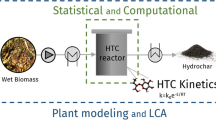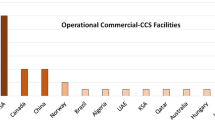Abstract—
Electricity generation with the use of secondary energy resources emerging as a by-product of industrial technologies is one of the promising lines for making the Russian power industry more efficient. The secondary energy resources produced during operation of some industrial installations (primarily the heat of high-temperature gaseous waste) have a significant potential for electricity generation. Apart from being efficiently used, this potential can also be further increased by subjecting the thermal and material flows of gaseous waste to integrated power and chemical accumulation on the basis of natural gas endothermic conversion reactions, with the high-temperature gaseous waste serving as an oxidizer and a heat source for the conversion. Mathematical models of industrial installations equipped with conversion reactors for carrying out integrated power and chemical accumulation are developed and investigated. An oxidizer consumption coefficient for the conversion process is used in the models, and the method for calculating it is described. The increase of secondary fuel chemical energy obtained for an industrial fuel installation in comparison with the converted natural gas is quite essential, making around 14%. With such an arrangement, the entire flow of gaseous waste becomes a high-quality secondary fuel. At the same time, the possibilities of decreasing the consumption of oxidizer for the conversion process to the optimal value equal to 1.0 are rather limited: its level should be no less than 3.0. The use of integrated power and chemical accumulation under the conditions of a fuel-free basic-oxygen converter is possible with the oxidizer consumption ratio for the conversion process down to 1.4, a level closer to its optimal value. The possibility to recycle in the integrated power and chemical accumulation process approximately 32% of the heat of gaseous waste with the entire mass flowrate of converter gas transformed into high-quality secondary fuel with a heat capacity of 2155°С is demonstrated. The use of integrated power and chemical accumulation in the basic oxygen furnace technology can make it possible to obtain an essential gain in the electricity generation potential in comparison with the direct use of natural gas for electricity generation purposes.




Similar content being viewed by others
REFERENCES
S. K. Popov, I. N. Svistunov, A. B. Garyaev, E. A. Serikov, and E. K. Temyrkanova, “The use of thermochemical recuperation in an industrial plant,” Energy 127, 44–51 (2017).
S. K. Popov, Thermochemical Recuperation in High-Temperature Heat Technology (Mosk. Energ. Inst., Moscow, 2018) [in Russian].
V. G. Nosach and A. A. Shraiber, “Improvement of the economic and ecological characteristics of steam-and-gas plants by means of conversion of natural gas in combustion products,” Int. J. Energy Clean Environ. 9, 39–46 (2008).
V. G. Nosach and A. A. Shraiber, “Enhancement of the efficiency of gas-turbine plants due to the joint use of thermochemical and steam recuperation,” Prom. Teplotekh. 33 (2), 46–49 (2011).
G. Verkhivker and V. Kravchenko, “The use of chemical recuperation of heat in a power plant,” Energy 29, 379–388 (2004).
D. I. Pashchenko, “Thermochemical recovery of heat contained in flue gases by means of bioethanol conversion,” Therm. Eng. 60, 438–443 (2013). doi https://doi.org/10.1134/S0040601513060062
A. Poran and L. Tartakovsky, “Energy efficiency of a direct-injection internal combustion engine with high-pressure methanol steam reforming,” Energy 80, 506–514 (2015).
V. A. Kurganov, Yu. A. Zeigarnik, A. V. Korabel’nikov, and I. V. Maslakova, “The Thermochemical principle of cooling based on steam conversion of methane,” Therm. Eng 43, 198–210 (1996).
S. V. Kartavtsev, Natural Gas in Reduction Smelting. Soot-Hydrogen Mixture and Energy-Chemical Accumulation (Mahnitogorsk. Gos. Tekh. Univ., Magnitogorsk, 2000) [in Russian].
K. Takagi, Kh. Saima, M. Yasukhiro, and M. Yasuo, RF Patent No. 2466192, MPK S21S5/38, Izobret. Polezn. Modeli, No. 31 (2012).
Takagi, Kh. Saima, M. Yasukhiro, and M. Yasuo, RF Patent No. 2536123, MPK S21S5/38, Izobret. Polezn. Modeli, No. 35 (2014).
M. Bal’dauf and T. Machullat, RF Patent No. 2569105, MPK F27D17/00, S21S5/38, F23J15/00, Izobret. Polezn. Modeli, No. 32 (2015).
C. Lingen, S. Xun, X. Shaojun, and S. Fengrui, “Thermodynamic analyses for recovering residual heat of high temperature basic oxygen gas (BOG) by the methane reforming with carbon dioxide reaction,” Energy 118, 906–913 (2017).
S. N. Petin, Development of a Prospective Model of Energy and Environmentally Efficient Production of Hydrogen Based on Natural Gas and Combining Processes in the Ferrous Metallurgy, Candidate’s Dissertation in Engineering (Moscow Power Engineering Inst., Moscow, 2009).
S. V. Kartavtsev and I. V. Portnova, RF Patent 2002812, MPK S10G9/34, Otkryt. Izobret., No. 37 (1992).
S. N. Petin, A. V. Burmakina, and V. A. Ippolitov, RF Patent No. 2637439, MPK S21S5/38, Izobret. Polezn. Modeli, No. 34 (2017).
S. N. Petin and A. V. Verlan, “Reclaiming converter gas for producing hydrogen,” in Proc. 8th Int. Sci.-Pract. Conf. Energy-Efficient and Resource-Saving Technologies in Industry. 100 Yeas of Domestic Design of Metallurgic Furnaces, Moscow, Oct. 10–12, 2016 (MISiS, Moscow, 2016), pp. 316–319. https://elibrary.ru/download/ elibrary_26994245_26653573.pdf.
S. N. Petin, “Reclaiming converter gases for producing hydrogen,” Vestn. Mosk. Energ. Inst., No. 1, 29–33 (2018).
V. N. Yurenev, “Natural gas saving reserves in metallurgy,” Gazov. Prom-st., No. 11, 36–38 (1985).
Q. Zhang, Z. Xiaoyu, L. Hongyou, N. Tuanjie, and L. Yu, “Waste energy recovery and energy efficiency improvement in China’s iron and steel industry,” Appl. Energy 191, 502–520 (2017).
HotOxyGlass Layman’s Report. http://ec.europa.eu/ environment/life/project/Projects/index.cfm?fuseaction= home.showFile&rep=file&fil=LIFE07_ENV_F_000179_ LAYMAN.pdf.
S. K. Popov and V. A. Ippolitov, Solving the High-Temperature Heat Technology Problems in Mathcad (Mosk. Energ. Inst., Moscow, 2009) [in Russian].
H. Kobayashi and B. Van Hasel, “CO2 reduction by oxy-fuel combustion: Economics and opportunities,” Presented at GCEP Advance Coal Workshop, Provo, UT, March 15, 2005. http://gcep.stanford.edu/pdfs/ RxsY3908kaqwVPacX9DLcQ/kobayashi_coal_mar05. pdf.
Z. Ligang and T. Yewen, “Overview of oxy-fuel combustion technology for CO2 capture,” CornerStone 1 (4), 48–52 (2013).
Key World Energy Statistics (The International Energy Agency, 2015).
US Energy Information Administration (Independent Statistics and Analysis). US Department of Energy. https://www.eia.gov/tools/faqs/faq.cfm?id=667&t=3.
I. N. Svistunov, Improving Energy Efficiency of High-Temperature Plants by Thermochemical Recuperation of Heat Waste, Candidate’s Dissertation in Engineering (Moscow Power Engineering Inst., Moscow, 2017).
R. S. Takhautdinov, Steel Production at the Oxygen-Converter Shop of Magnitogorsk Iron and Steel Works (Magnitogorsk. Dom Pechati, Magnitogorsk, 2001) [in Russian].
ACKNOWLEDGMENTS
The article was prepared with support of the Russian Federation Ministry for Education and Science as part of fulfilling the state assignment within the framework of competitive selection of scientific projects accomplished by the scientific teams of research centers and scientific laboratories at higher education institutions (application no. 13.3233.2017/PCh).
Author information
Authors and Affiliations
Corresponding author
Additional information
Translated by V. Filatov
Rights and permissions
About this article
Cite this article
Popov, S.K., Petin, S.N., Burmakina, A.V. et al. Integrated Power and Chemical Accumulation of High-Temperature Gaseous Waste from Industrial Installations. Therm. Eng. 66, 116–126 (2019). https://doi.org/10.1134/S0040601519020034
Received:
Accepted:
Published:
Issue Date:
DOI: https://doi.org/10.1134/S0040601519020034




